Two lamb castration methods that put focus on animal welfare
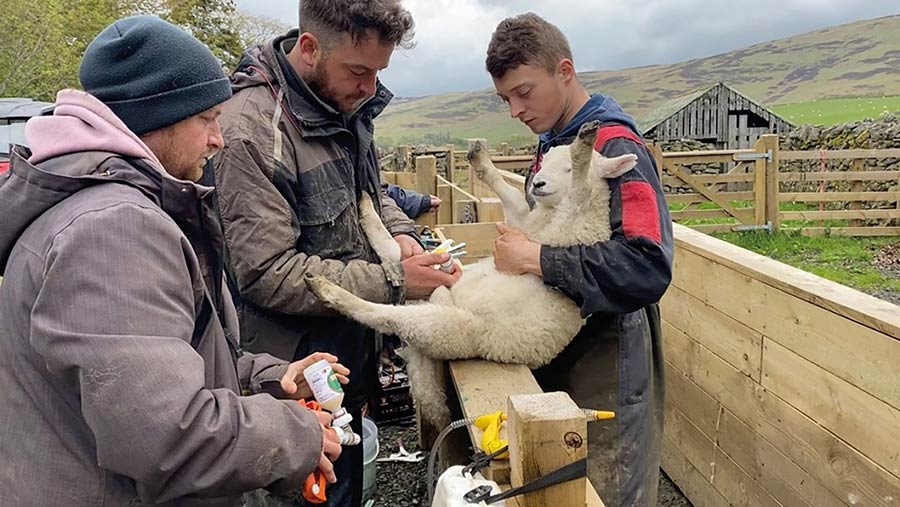 The Humes family process lambs at Sundhope Farm © Brian Eadie
The Humes family process lambs at Sundhope Farm © Brian Eadie Leading sheep farmers and vets are pushing for a full-scale reassessment of castration methods, with some even questioning whether it is needed at all.
The sight of recently castrated lambs kicking in pain is considered a major contention for consumers and some believe the clock is ticking for the trusty rubber ring.
Almost 15 years after the Farm Animal Welfare Council’s 2008 report into mutilation procedures on young lambs shed light on the subject, Farmers Weekly looks at recent developments in the field of castration and tailing.
See also: Castrating and tail docking lambs should be ‘last resort’
1. Short-scrotum castration
A farm trial on 120 male lambs has further highlighted the growth and welfare benefits of short-scrotum castration (SSC).
Malcolm MacDonald, a Ross-shire farmer and consultant with SAC Consulting, has undertaken SS castration on his tup lambs for two years, following a comparison with full castration (FC) in 2021.
He compared SSC on 60 lambs with FC on a further 60 in his 200-ewe flock and found SSC worked well. This is in line with work from Australia, New Zealand and the US, as well as studies at FAI Farms and those by the AHDB.
The lambs were treated as one group and put on silage aftermaths after weaning.
“I was concerned that the SSC lambs would grow too lean and be hard to finish, or they would look “tuppy”, but finished lamb buyers had no problems,” says Mr MacDonald.
“The SSC lambs were sold liveweight and did better or as well as the wethers. I am confident this practice can be a higher-welfare option.”
How it works
- Testes are pushed up into the inguinal canal while the empty scrotum is ringed. Starved of blood, the scrotum tissue dies and is shed
- This prevents thermoregulation of the testicles, which means sperm cannot be produced
Considerations
- Research suggests ram taint is not a worry
- Occasionally, rams will remain technically fertile, but they rarely have motile semen. In studies where treated tup lambs were kept with breeding ewes, no successful services were recorded
- There are still concerns that store tup lambs that look like rams (because of the normal testosterone levels) could be harder to sell
Benefits seen by Malcolm MacDonald
- Far less pain seen in ram lambs
- SSC twins weaned at 36kg compared with FC twins at 35kg due to additional testosterone
- Growth to final weighing was 11g/day more, at 254g/day
- Using SSC meant ewes and newborn lambs could be turned out to grass a day or two sooner because there was no concern about abandonment or predation of young male lambs following FC
2. Low-pain castration clip
South Country Cheviot breeding brothers Callum and Duncan Hume of the Sundhope flock are using ClipFitter for their third season this year.
Based in the Yarrow valley, near Selkirk, the high hill ground and challenging conditions mean most lambs are sold as stores, so castration is needed.
Sundhope flock
- 1,480 ewes, mainly South Country Cheviots
- Sells 1,400 store lambs annually
- About 300 rams lambs were kept entire to fatten last year
- Sells 12 or more South Country Cheviot tups a year privately and at the society sale at Lockerbie
- 1,600 ewes contract-farmed for Bowhill Farming and Innovis
The method is used across the six sheep families on each of Sundhope’s six groups, as well as the contract-farmed group next door.
About 100 Sundhope rams are kept entire each year, from which 20 are selected for breeding. Rams on the Innovis breeding programme are left entire.
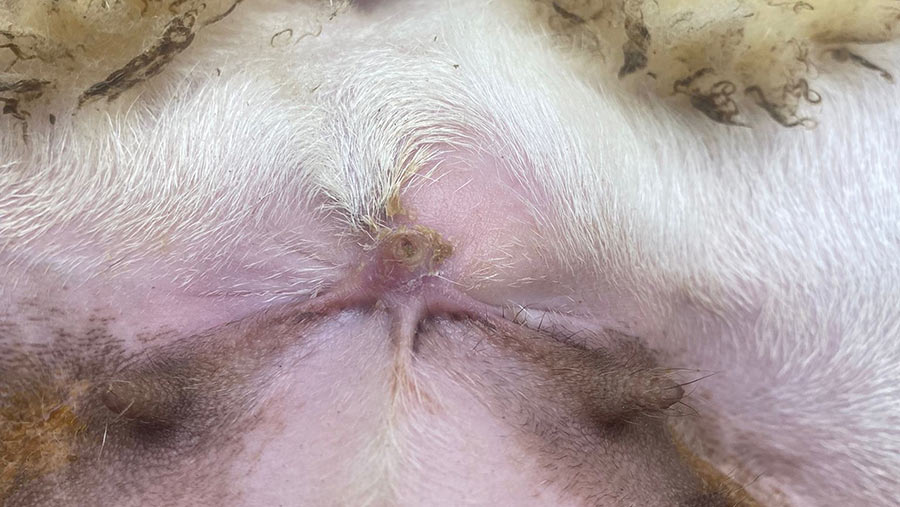
Scarring from castration using a conventional rubber ring © Brian Eadie
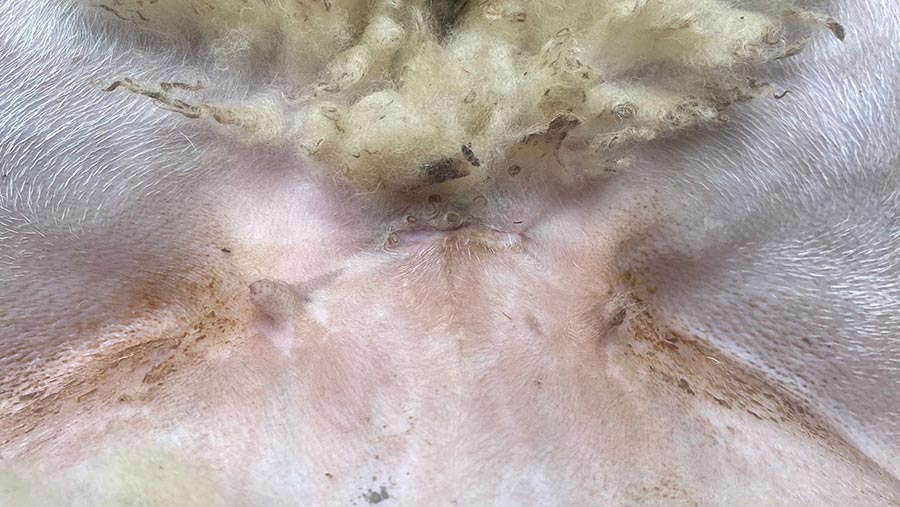
Scarring from castration via the ClipFitter system © Brian Eadie
How it works
- A clip made of a water-soluble plastic alternative is placed around the tail or scrotum and clamped on
- The cords, nerves and sperm cords are disabled on application
- Overcentre plier levers lock the clip in place
- It remains on the scrotum for a week or so before falling off and dissolving in the soil over time
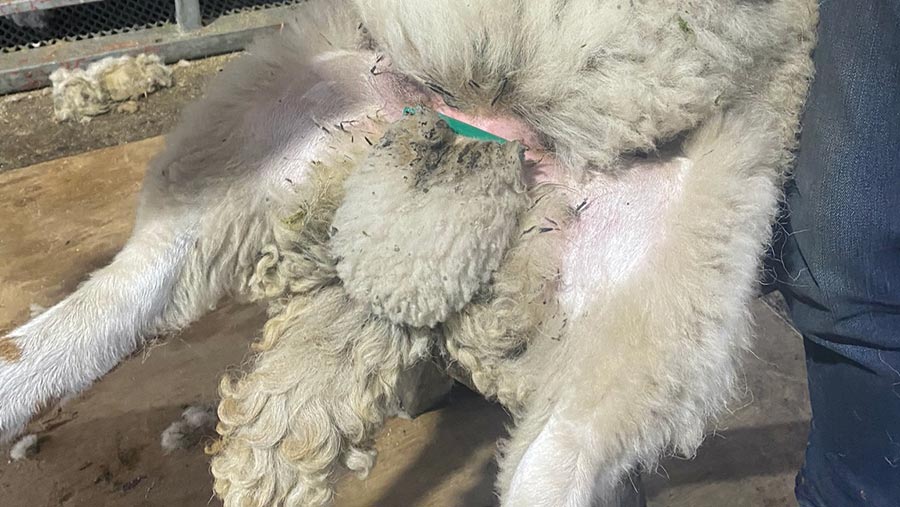
Lamb castrated with ClipFitter system © Brian Eadie
Considerations
- Currently only approved in Scotland for use in lambs more than seven days old
- Once up to speed, the system can comfortably see lambs tailed and castrated in 30 seconds. With someone holding the lamb and another person handing items over, three people can tail, castrate, orf-scratch (vaccine), keel-mark (gender), tag (ear identification) and inject (clostridials and fly protection) in about 50 seconds
- The equipment retails at about £240 for an applicator and 30p/clip
- Applicators are handmade with a three-month wait time, available from Eadie Bros
Benefits
- No signs of pain such as kicking on the floor or wriggling shown in lambs from seconds after application
- Higher welfare means Scottish law permits use up to three months from birth with no anaesthetic. By contrast, the limit for rubber rings is one week of age
- Clips come in three sizes to cover larger lambs
Other options for castration/tail docking
Farmers Weekly spoke to vets and advisers, who suggested several different approaches.
Bloodless castration – crushing the spermatic cords
- Like the ClipFitter system, a Burdizzo causes only short-term pain
- The higher-welfare credentials of this method mean authorities allow its use up to three months of age with no anaesthetic, and it is approved by Red Tractor
- Some schools of thought suggest using this before applying a rubber ring to sever the nerve supply would make the ring a less painful method
- The Prohibited Procedures of Protected Animals (Exceptions) (Scotland) Regulations 2010 outlawed using a Burdizzo and knife for tail docking in Scotland
System and management
- Creep-feeding systems selling ram lambs before sexual maturity could keep them entire for the growth benefits of testosterone
- However, rams can be sexually active from seven months (sometimes five to six months) and grazing separately from weaning to finishing is not always practical
- Some farms keep large singles and earlier-born lambs entire as they should be off the farm earlier. They then move on to short-scrotum castration, while the tail-enders are castrated with a ring
Genetics
- If castration frequency is reduced by system changes and separation, breeding for shorter tails, less wool, better dag scores or complete wool shedding could minimise the need to tail lambs
- This would be challenging for some breeds, but certain Exlana, Easycare and Wiltshire breeders have embraced this concept, and many hill breeds do not tail-dock
Hot iron
- A hot iron or electric docking iron that cuts and cauterises the tail simultaneously is permitted for use by UK farmers and approved by Red Tractor. A sharp blade alone is not allowed
- This method can be used up to two months of age, but only with anaesthetic
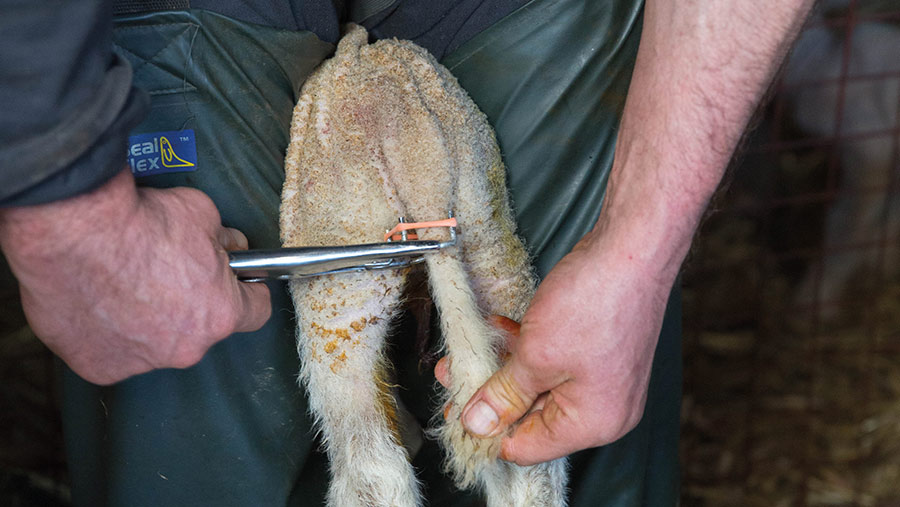
© Tim Scrivener
NumNuts
- A hand-held device delivers anaesthetic to a young lamb as the ring is applied to castrate/tail it. However, studies suggest pain from rubber rings peaks at 25 minutes and continues for three to four hours, by which time the anaesthetic may have worn off
- Use is not permitted in the UK, but trials have been done in Scotland. It was developed and is commercially available in Australia
Surgical docking
- Tail docking with a knife or scalpel may only be undertaken by a veterinary surgeon under anaesthetic and analgesic
